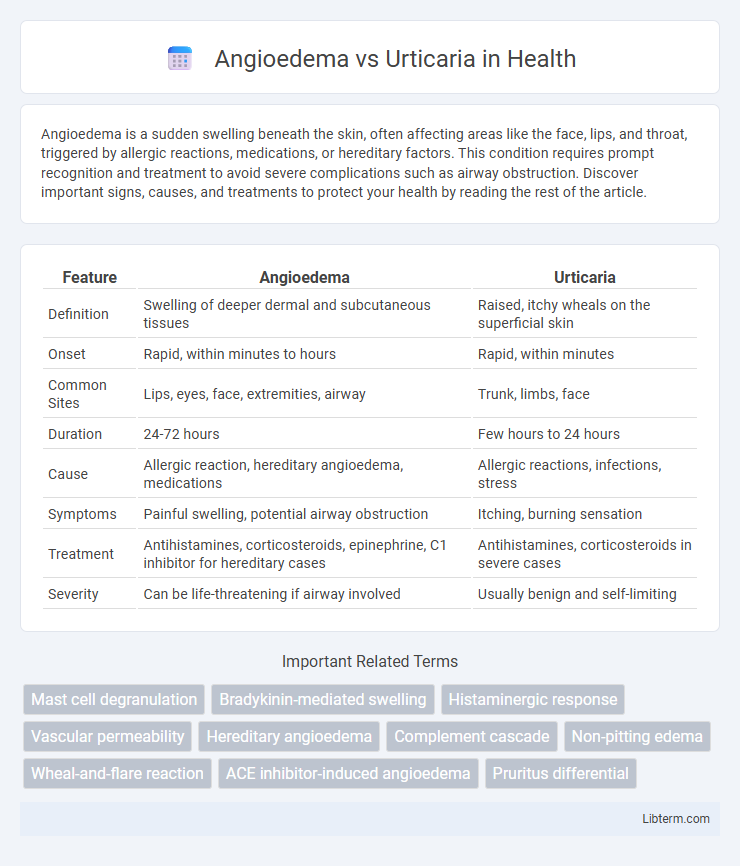Angioedema is a sudden swelling beneath the skin, often affecting areas like the face, lips, and throat, triggered by allergic reactions, medications, or hereditary factors. This condition requires prompt recognition and treatment to avoid severe complications such as airway obstruction. Discover important signs, causes, and treatments to protect your health by reading the rest of the article.
Table of Comparison
| Feature | Angioedema | Urticaria |
|---|---|---|
| Definition | Swelling of deeper dermal and subcutaneous tissues | Raised, itchy wheals on the superficial skin |
| Onset | Rapid, within minutes to hours | Rapid, within minutes |
| Common Sites | Lips, eyes, face, extremities, airway | Trunk, limbs, face |
| Duration | 24-72 hours | Few hours to 24 hours |
| Cause | Allergic reaction, hereditary angioedema, medications | Allergic reactions, infections, stress |
| Symptoms | Painful swelling, potential airway obstruction | Itching, burning sensation |
| Treatment | Antihistamines, corticosteroids, epinephrine, C1 inhibitor for hereditary cases | Antihistamines, corticosteroids in severe cases |
| Severity | Can be life-threatening if airway involved | Usually benign and self-limiting |
Introduction to Angioedema and Urticaria
Angioedema and urticaria are distinct yet interrelated allergic conditions characterized by swelling and redness of the skin, often triggered by allergens, medications, or infections. Angioedema primarily affects the deeper layers of the skin and mucous membranes, resulting in rapid swelling around the eyes, lips, and throat, which can pose a risk of airway obstruction. Urticaria, or hives, manifests as raised, itchy welts on the surface of the skin caused by histamine release, frequently accompanying angioedema but typically resolving faster.
Defining Angioedema: Key Features
Angioedema is characterized by rapid, localized swelling of the deeper layers of the skin and mucous membranes, often affecting areas such as the face, lips, tongue, throat, and extremities. It differs from urticaria by involving swelling below the skin surface, whereas urticaria, or hives, manifests as superficial, raised, itchy wheals. The key features of angioedema include pain or burning sensation, less itching compared to urticaria, and potential airway obstruction in severe cases.
Understanding Urticaria: Primary Characteristics
Urticaria, commonly known as hives, presents as raised, itchy welts on the skin caused by histamine release from mast cells, often triggered by allergens, infections, or stress. The welts typically appear rapidly, are variable in size and shape, and usually resolve within 24 hours without leaving bruises or scars. Unlike angioedema, which affects deeper skin layers causing swelling often around eyes or lips, urticaria primarily involves superficial dermal layers and rarely leads to significant tissue swelling.
Pathophysiology: How Angioedema and Urticaria Differ
Angioedema involves deeper dermal and subcutaneous tissue swelling due to increased vascular permeability mediated primarily by bradykinin or histamine, whereas urticaria affects the superficial dermis with transient wheals resulting from mast cell degranulation and histamine release. In angioedema, the pathophysiology may include C1 esterase inhibitor deficiency leading to unregulated bradykinin production, while urticaria is predominantly a histamine-driven hypersensitivity reaction triggered by allergens or autoimmune mechanisms. These distinct mechanisms result in angioedema presenting as localized, often painful swelling, contrasting with the itchy, raised plaques characteristic of urticaria.
Common Causes and Triggers
Angioedema is commonly triggered by allergic reactions to foods, medications like ACE inhibitors, and insect stings, while urticaria is often caused by infections, stress, and exposure to allergens such as pollen or pet dander. Both conditions can be induced by autoimmune responses, with histamine release playing a central role in symptom development. Identifying specific triggers through patient history and allergy testing is crucial for effective management of angioedema and urticaria.
Clinical Presentation: Signs and Symptoms
Angioedema typically presents as deep, sudden swelling of the skin and mucous membranes, primarily affecting the lips, eyes, and airway, with pain and warmth but usually no itching. Urticaria manifests as raised, red, itchy wheals that appear and disappear quickly on the skin surface, often accompanied by a burning or stinging sensation. Both conditions may co-occur, but angioedema poses a higher risk of airway obstruction, requiring prompt recognition of symptoms like facial swelling and difficulty breathing.
Diagnostic Criteria and Differentiation
Angioedema is characterized by deep dermal and subcutaneous swelling often affecting the face, lips, and airway, whereas urticaria presents as superficial, transient wheals with intense itching. Diagnostic criteria for angioedema include non-pitting edema lasting 24-72 hours without associated erythema or itching, while urticaria features erythematous, raised plaques that typically resolve within 24 hours. Differentiation is crucial as angioedema may indicate life-threatening airway obstruction requiring immediate intervention, while urticaria is primarily an allergic hypersensitivity reaction managed with antihistamines.
Treatment Approaches for Angioedema and Urticaria
Treatment approaches for angioedema primarily include antihistamines, corticosteroids, and epinephrine in severe cases, focusing on reducing swelling and preventing airway obstruction. Urticaria management centers on non-sedating H1-antihistamines as first-line therapy, with omalizumab or cyclosporine considered for chronic or refractory cases. Both conditions may require avoidance of triggers and, in hereditary angioedema, targeted therapies such as C1-inhibitor concentrates or bradykinin receptor antagonists.
Prognosis and Complications
Angioedema often presents with deeper tissue swelling that can lead to airway obstruction, posing a serious risk of respiratory complications and requiring prompt medical attention. Urticaria, characterized by superficial hives and itching, generally has a favorable prognosis with most cases resolving without long-term effects, although chronic urticaria can impact quality of life. Both conditions may coexist and, if untreated, can result in recurrent episodes with potential for significant morbidity, highlighting the importance of accurate diagnosis and management.
Preventive Strategies and Patient Education
Preventive strategies for angioedema focus on avoiding known triggers such as certain medications (ACE inhibitors), allergens, and physical factors like pressure or temperature changes, while urticaria prevention involves identifying and managing chronic triggers including stress, infections, and specific foods. Patient education emphasizes recognizing early symptoms, adhering to prescribed treatments like antihistamines for urticaria or C1-inhibitor replacement for hereditary angioedema, and developing action plans for acute episodes. Empowering patients with knowledge about trigger avoidance, timely medication use, and when to seek emergency care significantly reduces severity and improves quality of life.
Angioedema Infographic

 libterm.com
libterm.com